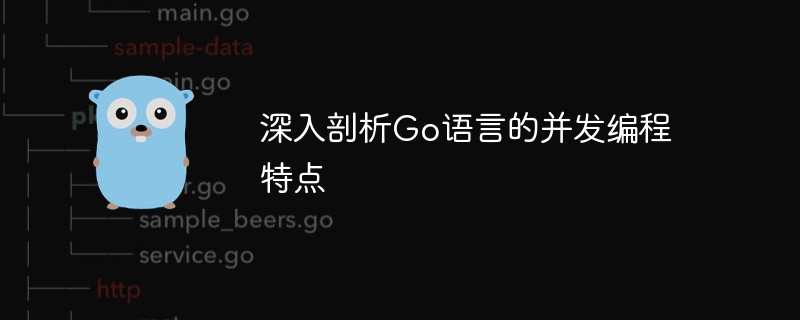

In-depth analysis of the concurrent programming features of Go language
Go language is a programming language developed by Google. An important feature of its design is its native support for concurrent programming. In modern computer systems, multi-core processors and distributed systems have become the norm. Therefore, achieving efficient concurrent programming has become an important task for a programming language. The concurrent programming features of the Go language make it more efficient and simpler to handle concurrent tasks. This article will delve into the concurrent programming features of Go language and provide specific code examples.
func printMessage(msg string) {
for i := 0; i < 5; i++ {
fmt.Println(msg)
time.Sleep(time.Second)
}
}
func main() {
go printMessage("Hello")
go printMessage("World")
time.Sleep(5 * time.Second)
}In the above code, we use the go keyword to create two goroutines that print "Hello" and "World" respectively. Through the time.Sleep function, we let the main goroutine wait for 5 seconds to ensure that the two child goroutines have enough time to perform the printing operation. Running the above code, we will find that the two goroutines print "Hello" and "World" alternately.
func sum(a []int, c chan int) {
sum := 0
for _, v := range a {
sum += v
}
c <- sum
}
func main() {
a := []int{1, 2, 3, 4, 5}
c := make(chan int)
go sum(a[:len(a)/2], c)
go sum(a[len(a)/2:], c)
x, y := <-c, <-c
fmt.Println(x + y)
}In the above code, we create a channel c, which can pass integer type data. In the sum function, we sum the input slices and send the result to channel c. In the main function, we created two sub-goroutines to sum the first half and the second half of the slice respectively, and then receive the result from the channel through <-c and convert the result Add and print out.
select statement to implement such multiplexing. Here is an example of using the select statement and timeout mechanism: func fibonacci(n int, c chan int) {
x, y := 0, 1
for i := 0; i < n; i++ {
c <- x
x, y = y, x+y
}
close(c)
}
func main() {
c := make(chan int)
go fibonacci(10, c)
for {
select {
case x, ok := <-c:
if !ok {
fmt.Println("channel closed")
return
}
fmt.Println(x)
case <-time.After(1 * time.Second):
fmt.Println("timeout")
return
}
}
} In the above code, we use select in the main function The statement monitors two channels: c and time.After(1 * time.Second). In the fibonacci function, we calculate the first 10 numbers of the Fibonacci sequence and send the results to channel c. In the main function, we use the for loop and the select statement to receive the result from c and print it out. The loop ends when c is closed. When it exceeds 1 second, time.After(1 * time.Second) will send a timeout signal, and the select statement will choose to execute the corresponding branch and print out "timeout" .
Summary:
Go language achieves efficient and concise concurrent programming through the combination of goroutine and channel. Through goroutine, we can easily create a large number of concurrent tasks and manage their life cycles efficiently. Through the use of channels, we can realize data sharing and communication between different goroutines, improving the accuracy and maintainability of the program. At the same time, the Go language also provides select statements to manage read and write operations on multiple channels, and a timeout mechanism to prevent the program from entering a deadlock state. These concurrent programming features give the Go language significant advantages in handling large-scale concurrent tasks and building high-performance systems.
The above is the detailed content of In-depth exploration of the characteristics of concurrent programming in Go language. For more information, please follow other related articles on the PHP Chinese website!




